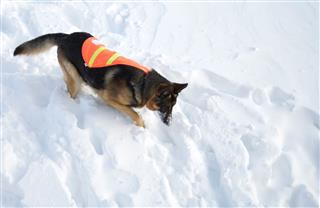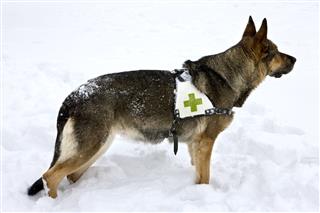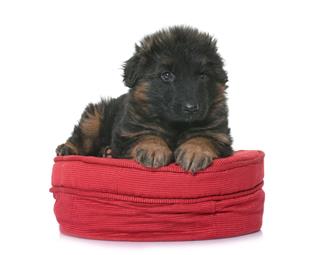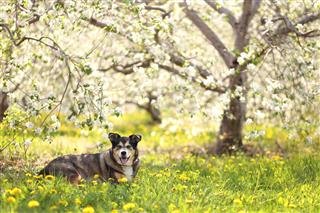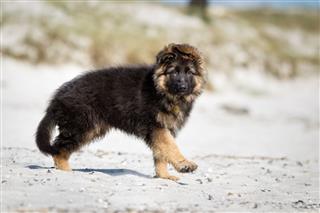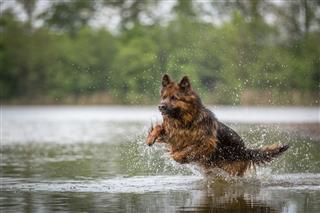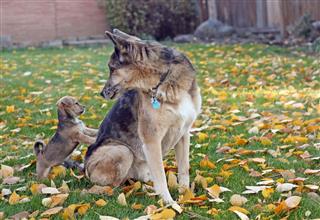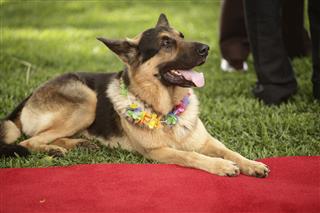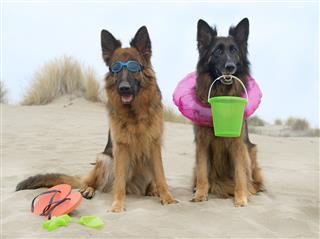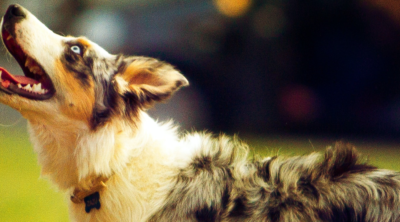
German Shepherds originated in 1899 at Karlsruhe, Germany. This breed is energetic and fun-loving, and very fond of children if well socialized, once a relationship is established. They are a brilliant breed for herding and guarding, making them an excellent companion, both at work and at homes.
Did You Know?
A German Shepherd continues to mature until the age of 36 months. Most people do not consider them as an adult until the female is 2 or more and the male is 2½ to 3 years of age.
German Shepherds are also known as Alsatians and GSDs. They live from 9-13 years, a very short life span for such a very lovable breed. They are kind, good-tempered, outgoing, agile, gentle, and very intelligent, making them very easy to train, once a proper bond is built with the handler or owner and the dog.
Since they are a large breed, they are often mistaken to have reached full maturity at a very young age. To prevent mistakes commonly made by GSD owners, such as overfeeding or underfeeding, here, we give you a German Shepherd growth chart, which has the weekly/monthly development of the puppy, along with a monthly weight growth rate chart, which will help new owners, existing owners, and dog lovers to better understand this breed better.
Puppy Growth Chart from Birth to 16 Months
Neonatal Period

Like all puppies, GSD puppies too are born with their ears and eyes closed, with a part of their umbilical cord still attached; this will fall off on its own in couple of days. They are completely dependent on their mother during this period, until 2 weeks after their birth. As their nervous system is still developing, puppies usually curl up when they are picked up. They are unable to eliminate, and need their mother’s help.
First Week
This is when the puppies begin to stretch their legs and arch their backs when they are picked up. They also begin to crawl around this time. They tend to develop early if they are handled by humans. Around the mid-fourth week, their eyes and ears begin to open. Their eyes are grayish blue in color, and cannot focus.
Second Week

In this week, they develop the ability to crawl better, and their eyes and ears would have fully opened. The puppies become a little more independent from their mother, and take their first wobbly steps. Also, they most importantly eliminate on their own. Around four and half weeks into their little lives, they begin to socialize with the others in their litter. They will pile up on each other and try to wag their tails. This is when they also experience the growth of their first incisor teeth.
Third Week
By this time, the puppies would have mastered walking, and only depend on their mother for milk. They begin to explore their surroundings. Puppies learn to identify their own species, and can bond better with humans.
Fourth Week
Socializing plays an important part during this stage. They communicate and play/fight with their siblings, humans, toys, and other animals. By this time, they can also consume semi-soft food, in addition to their mother’s milk.
At this age, puppies are fearless in exploring their environment. As such, as the human around them, you’ll need to keep everything out of their reach. They also exercise their jaws, and chew on any and everything within their reach.
Fifth to Eighth Week
Now is when their fear response begins to set in. This is the perfect time to begin socializing more with others. They begin to learn to trust. This is a crucial period for their future relationships, especially with humans and other pets and animals. You want to make sure you are socializing them to all sorts of things.
Sixth Week

In the preteen months of a puppy’s life, thier personalities really begin to come out. On interaction with other dogs, they begin to sniff their noses and tails, and learn doggie body language and etiquette. In play, they try to chew on each others ears and snouts.
Seventh to Twelfth Week
This is the perfect time for crate training, housebreaking, walking on a leash, getting them used to grooming, and handling. They are getting to be lots of fun at this age, and have a very small attention span. So, be patient. Little treats would help bring back their attention.
Their ears may start standing up at this time. Do not panic if their ears appear floppy and lopsided; it takes a little time for them to stand up straight.
Third Month

The juvenile stage stretches into sexual maturity. At this stage, their ears are straighter. They would have also developed motor skills, and are ready to learn new skills and tricks. You should be continuing the socialization since the socialization window is almost closed, at 16 weeks. Positive reinforcement training is important. GSD’s are very smart and love to learn. They are also a sensitive breed, so you never want to from punish or scold them, as it is never necessary to do. Use treats to train. They are fun dogs to clicker train! If they get bored or lose focus, stop training. Be patient; they are only puppies.
Fourth and Sixth Month
At this stage, puppy teeth start falling, and permanent ones replace them, beginning with their incisors. Social maturity takes a longer time to develop than sexual maturity.
Sixth Month
By now, their size would have increased considerably, and they would look more like adults. The puppy has now stepped into its teen months, or young adult, with a full set of adult teeth.
Female puppies reach their sexual maturity and can have their first heat this early.
Seventh to Twelfth Month
Males reach their sexual maturity by this time. They raise their legs to urinate at this stage. Their getting bigger and more independent.
Fourteenth to Sixteenth Month
You can take up positive good manners training, as the dogs are calmer and can concentrate better by this time. They should have bonded better with you by now, and you too would have learned their body language as they are able to communicate better with you.
Now you know how your puppy will develop into a young adult. But, take a look at the grid below to have a better understanding of your puppy’s age-to-weight ratio, so that you can take better care of its nutrition and exercise. These weights are approximate, of course! Unhealthy dogs, overfed or underfed dogs, can face problems like hip and elbow dysplasia, gastric dilatation-volvulus, degenerative myelopathy, allergies, etc.
German Shepherd Growth Chart by Weight and Age in Months
| Age in Months | Weight in lbs: Male | Weight in lbs: Female |
| 1 | 9.2 | 7.2 |
| 2 | 19.9 | 16.6 |
| 3 | 31.3 | 26.7 |
| 4 | 41.8 | 36.2 |
| 5 | 50.6 | 44 |
| 6 | 57.4 | 50.1 |
| 7 | 62.6 | 54.4 |
| 8 | 66.4 | 57.5 |
| 9 | 69.4 | 59.7 |
| 10 | 72 | 61.5 |
| 11 | 74.3 | 63.1 |
| 12 | 76 | 64.2 |
Remember, this breed loves to work alongside humans and other animals. They are emotional, intelligent and sensitive, and make great pet companions if socialized well and trained early. A healthy and loved puppy is a happy puppy. Treat them well, and they will grow up to be the best friend and companion that you could ever ask for.




